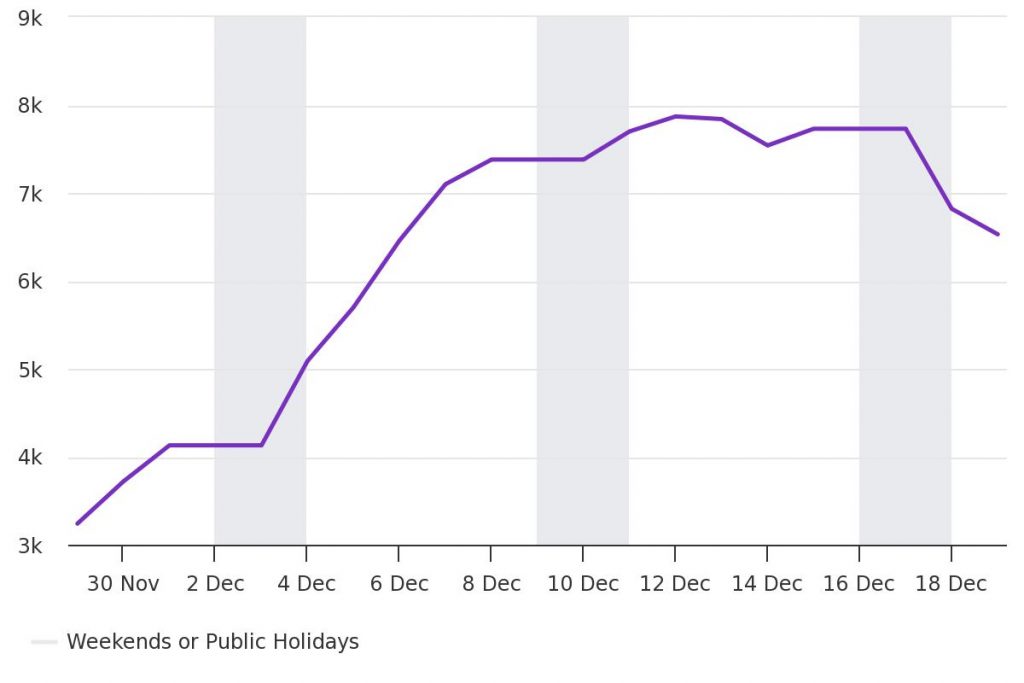SINGAPORE: The Ministry of Health started reporting on daily COVID-19 case numbers on Tuesday (Dec 19), and there has been somewhat of a decrease. The seven-day moving average number of cases on Dec 12 was 7,870. By Dec 19, it was estimated to be at 6,530.
Nevertheless, these numbers are still significantly higher than in the rest of 2023, and the public, whom the MOH “strongly encouraged” to put masks on when in crowded places, should not relax their guard.


On Dec 15, MOH’s COVID-19 report showed a 75 per cent increase in infection numbers, as well as increases in hospital admissions and average daily Intensive Care Unit (ICU) cases.
The ministry also announced additional measures to protect Singapore’s healthcare capacity.
Along with opening a second treatment facility for COVID-19 patients, MOH urged the public to take personal responsibility, including staying home when they feel unwell and wearing a mask in crowded public spaces, especially in indoor settings, or when visiting or interacting with vulnerable persons, as well as staying up to date with their vaccines.
However, despite the relatively high numbers of infections, experts say this should not cause too much concern, but everyone should remain proactive.
People should “just be sensible about taking precautions about their health, not go to work or school if they are unwell and seek medical attention instead,” NUH’s Professor Paul Tambyah, the president of the International Society for Infectious Diseases, is quoted in The Straits Times as saying.
The current wave is what we should expect of endemic COVID-19, just like we see with endemic influenza and all the other common respiratory infections.
There’s no more reason to worry about the COVID-19 wave than about similar influenza waves in the past. But just because we should not be consumed by anxiety, it doesn’t mean we should do nothing at all,” Associate Professor Alex Cook from the NUS Saw Swee Hock School of Public Health, told ST, adding that the real number of COVID-19 infections could be much higher since most people who have only mild symptoms do not usually seek medical attention.
On Tuesday (Dec 19), the World Health Organisation announced that the sub-variant JN.1, which MOH said was responsible for most of the new infections in Singapore, is now classified as a separate variant of interest from its parent lineage BA.2.86.
NEW: #COVID19 variant of interest JN.1
Due to its rapidly increasing spread, WHO is classifying the variant JN.1 as a separate variant of interest (VOI) from the parent lineage BA.2.86. It was previously classified as VOI as part of BA.2.86 sublineages.
Based on the available… pic.twitter.com/lvyd3sq1f7
— World Health Organization (WHO) (@WHO) December 19, 2023
“Due to its rapidly increasing spread, WHO is classifying the variant JN.1 as a separate variant of interest (VOI) from the parent lineage BA.2.86. It was previously classified as VOI as part of BA.2.86 sublineages.
Based on the available evidence, the additional global public health risk posed by JN.1 is currently evaluated as low. Despite this, with the onset of winter in the Northern Hemisphere, JN.1 could increase the burden of respiratory infections in many countries,” said the WHO.
Read also: COVID-19 cases up 75%; MOH ‘strongly encourages’ masking up in crowded places /TISG

